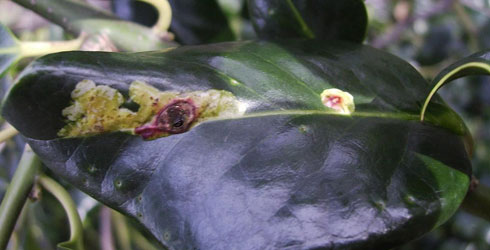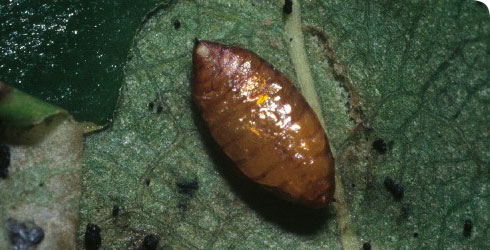Phytomyza ilicis (holly leaf-miner)
As its common name implies, Phytomyza ilicis is a miner in the leaves of holly (Ilex aquifolium).
The maggot-like, legless larvae feed between the upper and lower surface of the leaves and form characteristic blotch mines, usually only 1 per leaf. The mining activities of the larvae cause some aesthetic damage to the host plant and can weaken young plants in nurseries.
The adult holly leaf miner is a small black fly belonging to the family Agromyzidae. It is the only species of leaf-miner recorded on holly in Britain.
Species detail
-

Taxonomy
Larvae use their mouthparts like a coal miner's pickaxe to cut their way through soft leaf tissues, moving their 'head' up and down as they go. Find out what they look like.
-

Distribution and habitat
Phytomyza ilicis is common across northern parts of the world, and can be found in woodlands, hedgerows, parks and gardens, wherever holly grows. Find out where you might spot its tell-tale mines.
-

Biology
As it develops, the fly larva tunnels into the leaf blade, feeding as it goes. It finally emerges as an adult several months later through a characteristically shaped semi-circular exit slit. Find out what can change the shape of the exit hole.
-

References
Get reference material for Phytomyza ilicis.
Images

A holly leaf showing the characteristic blotch mines of Phytomyza ilicis (the holly leaf-miner).

Dead Phytomyza ilicis pupa in blotch mine in holly leaf.
© Malcolm Storey, BioImages, Creative Commons Attribution-NonCommercial-ShareAlike 2.0
Dead Phytomyza ilicis pupa in blotch mine in holly leaf.
© Malcolm Storey, BioImages, Creative Commons Attribution-NonCommercial-ShareAlike 2.0
Phytomyza ilicis.
© Creative Commons Attribution-Share Alike 3.0 UnportedGlossary
Frass
Debris produced by burrowing insects.
Mesonotum
The upper surface of the middle segment of the thorax.
Petiole
The stalk of a leaf.
Spiracles
Openings that allow gas exchange in insects.
Author
Dr Brian Pitkin
